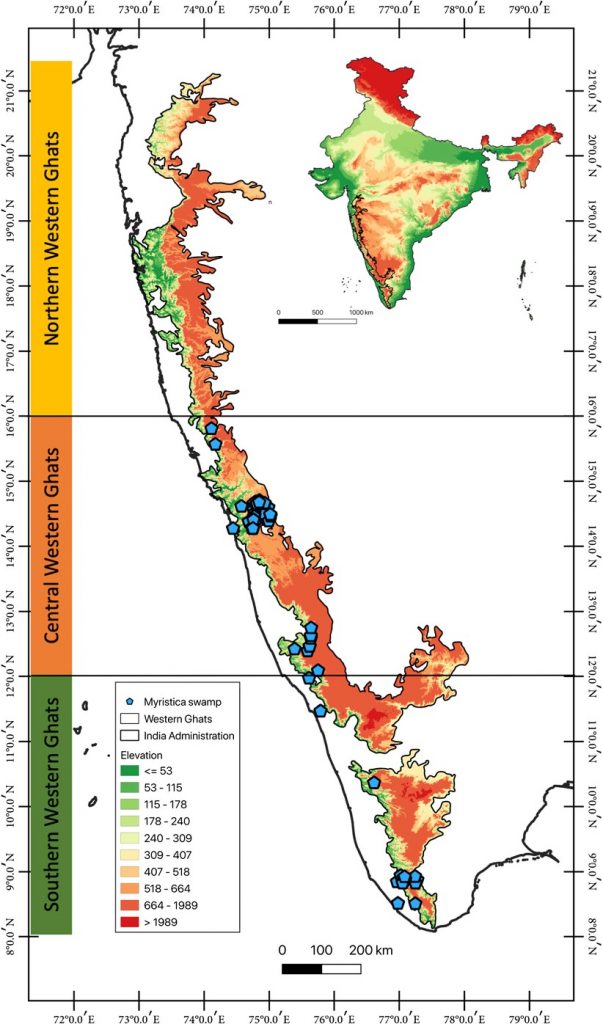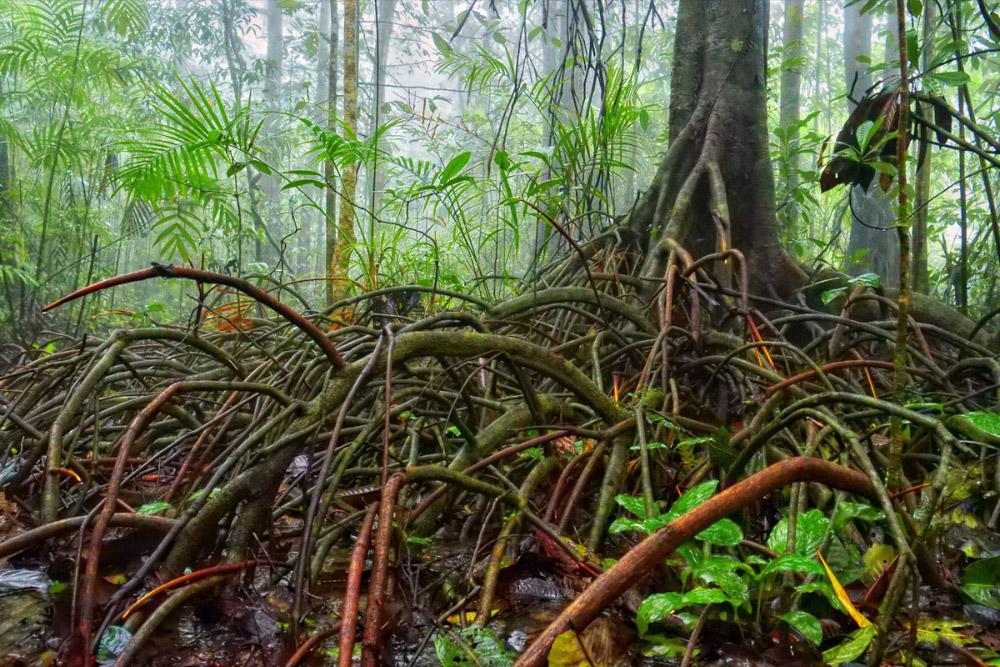Introduction
A review paper focuses on the importance of the threatened Myristica freshwater swamps, their ecology, and prior research on them. It focuses on the need for conservation initiatives to save the last few Myristica swamps in India.
What are Myristica swamps?
Myristica swamps are freshwater swamps predominated by members of the Myristicaceae family. These forests are characterized by trees with large protruding roots jutting out of waterlogged soil which remains inundated throughout the year. They have evolved over millions of years and are comprised of old-growth trees. In India, these unique habitats occur in the Western Ghats and a smaller distribution exists in the Andaman and Nicobar Islands. The formation of these swamps is dependent on abiotic conditions like the shape of the valley between the forested hills, the amount of rainfall a place receives (with an average of 3000 mm), and water availability throughout the year. Typically, Myristica swamps are seen next to rivers and help in retaining water and act as a sponge, ensuring perennial water availability. Historically, they formed a large hydrological network all along the Western Ghats.
Species assemblages
Most plant species in these swamp forests are restricted in their distribution and have specific structural and physiological adaptations suited for the swamp. According to studies, approximately 79 species of trees, 26 species of shrubs, 27 species of climbers, and 44 species of herb species have been recorded from Myristica swamps. Myristica swamps display high floristic endemism, with studies recording 23 tree species, endemic to the Western Ghats.
Myristica swamps are refugia for many vertebrate and invertebrate faunal species. This is due to stable macroecological conditions like high humidity, moderate temperature, and macrohabitat availability. One example is the Myristica Swamp Treefrog (Mercurana myristicapalustris), only reported from a few pockets of the Shendurney and Peppara Wildlife Sanctuaries in Kerala. Three endemic freshwater fishes have also been reported from Myristica swamps. Hymenopterans were the most abundant and diverse group of insects followed by assemblages of herbivorous insects in the canopy of trees. Studies have shown over 206 species of butterflies from the swamps in Kerala and over 80 species of plants native to these swamps are host plants for butterflies. However, gaps continue to remain in our understanding of this biodiversity and more species will likely be discovered.
Distribution of Myristica swamps

Location of Myristica swamps in the Western Ghats. © Ranganathan et al. 2021 Wetlands Eco. Manage
Threats to Myristica swamps
Myristica swamps today exist as small, isolated pockets and are one of the most threatened ecosystems in India. Today, many swamps are in reserve forests or sacred groves. Myristica swamps have traditionally been offered some degree of protection from cultural and religious beliefs, but only some come under the protected area network (in Kerala and Karnataka). The threats to Myristica swamps come from the conversion of land for hydel projects, paddy fields or horticulture gardens, eucalyptus, teak, and areca nut plantations. Diversion of water from the swamps to the plantations and the building of check dams for potable water is detrimental to these ecosystems that have otherwise evolved to survive in perennially flowing water. It also threatens soil productivity and chemistry and leads to water security in the region. These swamp forests are also exploited for non-timber forest products (NTFP) collection and medicinal plants. For example, Myristica fragrans are commercially cultivated and their seed and mace are commonly used as a spice and in traditional medicine. Loss of Myristica swamps directly threatens species adapted to live in these swamps with extinction while losing out on important ecosystem services provided by these swamps.
Conservation
Overall, there is a need for a coherent policy on Myristica swamp conservation that involves local communities and the forest department of the respective states. Current Myristica sites should be designated as community conservation areas and the focus should be on the ecological restoration of degraded swamps and their biodiverse elements. A formal designation of ‘Myristica swamp forests’ may be a crucial first step in protecting them from land conversion and other forms of destruction. The scope of research on Myristica and other freshwater swamps of India must also be increased to cover more breadth than their current assessment for a deeper understanding of these ecosystems, assess the scale of damage to the swamps in real-time, and formulate a comprehensive protection plan for each site.
The paper referred to in this article titled ‘A review of research and conservation of Myristica swamps, a threatened freshwater swamp of the Western Ghats, India’ was published in the peer-reviewed scientific journal Wetlands Ecology and Management and can be accessed at https://doi.org/10.1007/s11273-021-09825-5


 CI is a non-profit, non-commercial portal that aims to facilitate wildlife and nature conservation by providing reliable information and the tools needed to campaign effectively.
CI is a non-profit, non-commercial portal that aims to facilitate wildlife and nature conservation by providing reliable information and the tools needed to campaign effectively.